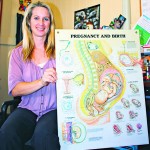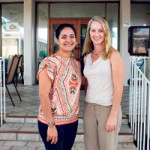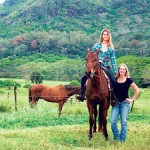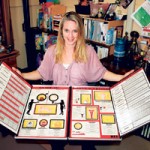Our Teen Pregnancy Problem
With a teen pregnancy rate higher than the state average, Kaua’i has a problem. Cara Sadira of Child and Family Service is working to change that while also lowering the rate of sexually transmitted diseases. Part of the problem, she says, is that sex is a taboo topic in too many homes
Kaua’i has the highest teen pregnancy rate in Hawaii, which Cara Sadira of CFS is working to change
Teen pregnancy is a serious issue on Kaua’i. Don’t believe it?
Consider that 36.8 percent of teens in Kaua’i high schools report they’ve had sex, and 22 percent of those who are sexually active report they also drank alcohol or used drugs before the last time they had intercourse. And of kids who are sexually active, less than half – just 46 percent – say they use condoms.
And 3.5 percent of total births on Kaua’i are to teen mothers, according to the 2012 State of Hawaii primary care needs assessment data book.
The Garden Isle is not alone. Hawaii as a state ranks 16th highest in the country for teen pregnancy, with 2.4 percent of total births to teen mothers. The Big Island tied Kaua’i for the highest rate.
- With a teen pregnancy rate higher than the state average, Kaua’i has a problem. Cara Sadira of Child and Family Service is working to change that while also lowering the rate of sexually transmitted diseases. Part of the problem, she says, is that sex is a taboo topic in too many homes. Amanda C. Gregg photo
- Cara Sadira with coworker Chanella Asuncion. Amanda C. Gregg photo
- Suraya David-Sadira and mom, Cara. Photo courtesy Cara Sadira
- Kalei Asuncion, Paul Daly, Chaleiyeh Asucion, Chanella Asuncion, and Keira Asuncion. Photo courtesy Chanella Asuncion
- One of the tools Sadira uses to teach teens about contraception. Amanda C. Gregg photo
And teen pregnancy is just part of what concerns Cara Sadira, program director for Child and Family Service. Of Hawaii youths infected with HIV/AIDS six in 10 are unaware of it a figure that holds true nationally – perhaps in part because an estimated 16 percent of Isle youths weren’t taught about HIV/AIDS infection in school.
Sadira is on the frontlines as facilitator of CFS Teen Pregnancy Prevention classes. The real goal is to help young adults realize dreams and life goals, while increasing awareness of abstinence, contraceptives and sexually transmitted disease (STD) prevention.
“The biggest challenge with the project is it’s taboo,” Sadira says. “Teens who we know need the class often are embarrassed to admit that they would like the information. Parents are embarrassed to encourage their youths to attend.
More telling statistics – all of which have human faces. According to the 2011 Hawaii Youth Risk Behavior Survey conducted by the Centers for Disease Control and Prevention, 5 percent of Hawaii youths had sexual intercourse before the age of 13. Eight percent have had sexual intercourse with four or more partners, and a whopping 79 percent of sexually active youths didn’t use birth control the last time they had sexual intercourse.
“As teens mature, their bodies change and they need to understand that changing process, and how to negotiate the many challenges of sex,” Sadira says.
A single parent herself, she is raising daughter Suraya David-Sadira, 15. “I fully understand the challenges of what lies ahead for many of the teen moms on our island,” she says.
Her colleague, program facilitator Chanella Asuncion, agrees. The former teen mom, who was born and raised on Kaua’i, had her first child at age 16.
“As a teen mom, there were many struggles and it was very difficult. There weren’t classes like this when I was a teen, and I was not able to learn the things that we are teaching our youths today,” Asuncion says. “Today, teens can take these classes and better understand how to protect themselves and, in doing so, protect their futures.”
Asuncion now has three daughters, Kalei, 15, Keira, 11, and Chaleiyah, 8.
Statistically speaking, in addition to raising a child, teen moms have an overwhelming number of issues to face. It’s part of why prevention work is so critical.
“Many do not graduate high school, and many children of teen parents are supported by welfare. Often, teen mothers end up being single parents, and single parents have less economic stability, higher depression rates, and their children are in higher-risk categories for poor academic performance, obesity and delinquency,” she says. “Also, the job of a single parent demands a great deal of strength and a personal reserve from which a person just needs to keep constantly moving forward. Of course, single-parent families can be very happy and healthy. It’s just a great deal of hard work as well.”
Regarding pregnancy rates, she says “these are teen birth rates, and not teen pregnancy rates,” notes Sadira. “The teen pregnancy rates are much more difficult to track. Kaua’i County is tied with Hawaii County as the highest rate of teen birth in the state. Waimea has the highest rate on Kaua’i (5.4 percent). We do pay special attention to Waimea, offering several Making Proud Choices programs available through Nana’s House in collaboration with the Boys and Girls Club.”
Sadira is originally from Maryland, where her father was a Methodist minister. Back in those days, she says, the church often relocated its ministers.
“I never lived in a town more than four or so years,” she recalls. “I grew up with my dad working very hard to bring needed programs and services to the community.” Her mother was a social worker, and Sadira says her family followed the principle of doing whatever they could to help others. “Our dinner table discussions were always about what we were able to do to help someone that day. Our family was extremely service-oriented.”
With her daughter as a top priority in her life, Sadira moved to Kaua’i after working as a backpacking guide for several years on the West Coast so she could work during the day and be home with her daughter at night. She went on to earn her master’s degree in nonprofit management, and got her start at CFS in April 2012.
“This strikes a personal chord for me,” she says of her current job. “I believe that it is possible to educate teens so that they can learn negotiation skills, choosing abstinence in the face of peer pressure, or learning how to practice safe sex to avoid pregnancy and sexually transmitted infections or disease.”
Sadira says just being able to reach one teenand to prevent him or her from having to live with HIV or another serious STD is something she considers a success, as is preventing teen pregnancy. Though prevention is hard to track, she and staff members certainly have reached a great number of youths throughout the island. That outreach includes 7- to 12th-graders at Kanuikapono Charter School in Anahola, the Waimea Boys and Girls Club, and individual clients of Child and Family Service.
“The great thing about our class is that we are able to have kids think ahead about being in an emotionally charged situation, and come up with a plan for responding to that situation,” she says.
Sadira also works with island therapists, parents and other members of the community to participate in programs, and has been collaborating with the nonprofit Hale Opio to provide the program to agencies that work with youths, as well as training for other providers.
She is hoping to reach even more people during her island youth spring break camp March 18-22.
“This camp will have fun activities, as well as our Making Proud Choices curriculum. We also will be offering some fun camps over the summer.”
The camp-style atmosphere harkens back to Sadira’s prior work experience on the Mainland that included taking at-risk youths on guided adventure trips around the West Coast.
“What I really enjoyed about taking teens on guided backpacking adventures is that it gave them something to be excited and passionate about,” she says. “As a group, a bunch of teens would wake early and work hard to get to the summit of a mountain … I believe teens need something thrilling and exciting that they do together that is healthy and guided by adult supervision.”
Sadira also is looking forward to a good community turnout for her upcoming outreach classes, which are currently in session but begin anew in April in Kapa’a and Waimea.
“Our classes include fun incentives for the kids – and snacks. The last day of the class, we have a pizza party.”
When she’s not working, Sadira enjoys spending time with her daughter – and their horse Kona.
“We are training him up, as we bought him when he was a little, shy, wild colt,” she says. “We are so busy that the best time for us to spend with our horse is before school and work.
We don’t have any time after work. We spend early mornings as the sun is rising working, training and riding him. We get out there while it is still dark, and tack him up b y the headlights of the car. The sun rises while we are warming him up. It’s incredibly rewarding to train a horse together while the sun is rising over the Kapa’a beaches first thing in the morning. It’s a great family activity.”
The free Teen Pregnancy Prevention Spring Break camp, for youth ages 12 to 15, will be held March 18-22 from 9 a.m. to 4 p.m. For more information, email csadira@cfs-hawaii.org








